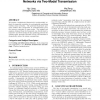139 search results - page 14 / 28 » Model-Based Design Exploration of Wireless Sensor Node Lifet... |
CCR
2010
13 years 7 months ago
2010
We present a sophisticated framework to systematically explore the temporal correlation in environmental monitoring wireless sensor networks. The presented framework optimizes los...
SENSYS
2009
ACM
14 years 2 months ago
2009
ACM
This paper describes Mercury, a wearable, wireless sensor platform for motion analysis of patients being treated for neuromotor disorders, such as Parkinson’s Disease, epilepsy,...
CODES
2009
IEEE
13 years 11 months ago
2009
IEEE
Technological advancements due to Moore’s law have led to the proliferation of complex wireless sensor network (WSN) domains. One commonality across all WSN domains is the need ...
WCNC
2008
IEEE
14 years 2 months ago
2008
IEEE
—The hot spot problem is a typical byproduct of the many-to-one traffic pattern that characterizes most wireless sensor networks: the nodes with the best channel to the sink are ...
IJSNET
2006
13 years 7 months ago
2006
: To extend the functional lifetime of battery-operated Wireless Sensor Networks (WSNs), stringent sleep scheduling strategies with communication duty cycles running at sub-1% rang...

